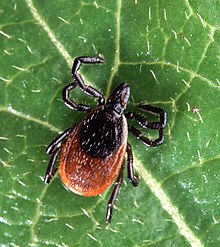
Finally, some good news in the treatment of Lyme disease. A recent study found that treating with 2 or 3 antibiotics at once is more effective in clearing Lyme disease bacteria than just treating with a course of one antibiotic (which is what is done now). In other words, a combination therapy is superior.
A single course of antibiotics treats most Lyme disease infections, but not in about 10 to 20% of patients. Studies find that this is because the Lyme disease bacteria hide in the organs (the sneaky devils!). The Lyme disease bacteria (Borrelia burgdorferi) is transmitted by tick bites.
 The study was done in mice with persistent Lyme disease, but the results also (probably) apply to humans with persistent Lyme disease infections. None of the single antibiotics completely eradicated the bacteria, but the following 4 dual combinations were effective: doxycycline + ceftriaxone, dapsone + rifampicin, dapsone + clofazimine, doxycycline + cefotaxime. Also effective were 3 triple antibiotic combinations: doxycycline + ceftriaxone+ carbomycin, doxycycline + cefotaxime+ loratadine, dapsone+ rifampicin+ clofazimine. The drugs were given for 28 days two months after infection.
The study was done in mice with persistent Lyme disease, but the results also (probably) apply to humans with persistent Lyme disease infections. None of the single antibiotics completely eradicated the bacteria, but the following 4 dual combinations were effective: doxycycline + ceftriaxone, dapsone + rifampicin, dapsone + clofazimine, doxycycline + cefotaxime. Also effective were 3 triple antibiotic combinations: doxycycline + ceftriaxone+ carbomycin, doxycycline + cefotaxime+ loratadine, dapsone+ rifampicin+ clofazimine. The drugs were given for 28 days two months after infection.
Next step is testing this in humans with persistent Lyme disease.
From Medical Xpress: Combined antibiotics more effective against Lyme disease: Study
Researchers at Tulane University have found that a combination of antibiotics is more effective in treating Lyme disease than the commonly prescribed course of one single antibiotic. This finding, published in Frontiers in Microbiology, could pave the way for improved Lyme disease treatments, particularly in persistent cases that have not responded to standard antibiotic treatment.
Lyme disease, caused by the bacterium Borrelia burgdorferi and transmitted through tick bites, is a growing health concern with more than 476,000 estimated cases annually in North America alone. While most cases resolve with a short course of oral antibiotics, a notable percentage of patients develop chronic symptoms known as post-treatment Lyme disease due to delayed or insufficient treatment.
The study, led by associate professor of microbiology and immunology, Monica Embers, Ph.D., involved a series of experiments using various antibiotics both alone and in combination in a mouse model of Lyme disease. The research team used multiple detection methods to assess the efficacy of treatments.
While none of the single antibiotics completely eradicated the persistent infection after a 28-day treatment course, several combination therapies of already FDA-approved drugs, were successful in clearing the infection.
Specifically, four different dual combinations of antibiotics (doxycycline and ceftriaxone; dapsone and rifampicin; dapsone and clofazimine; doxycycline and cefotaxime) and three triple combinations of antibiotics and antimicrobials (doxycycline, ceftriaxone and carbomycin; doxycycline, cefotaxime and loratadine; dapsone, rifampicin and clofazimine) eradicated persistent infections of the bacteria. These results suggest a need for further studies of combination antibiotic therapies in successfully eradicating Lyme disease.
"Lyme disease is a complicated disease due to the evasive nature of Borrelia burgdorferi, which hides in organs soon after infection," Embers said. "This finding could be a game-changer in how we approach this complex and often debilitating disease."
